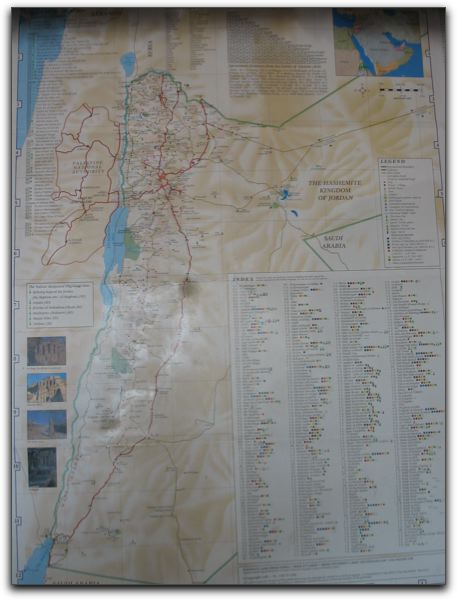

A recent interesting article in Ha’aretz indicates that the “Green Line” has been erased from most Israeli maps as well.
Another early wake-up and extensive breakfast buffet, on the last morning of our trip following our only night in Jordan - at the Petra MovenPick Resort Hotel in the Jordan Great Rift Valley. We’re told President Bush will stay here tomorrow as part of his visit to Jordan which begins in Amman today.
Fadi encourages us to vote for Petra as our favorite as one of the “New 7 Wonders” of the world.
We also learn a general strike in Israel began at 6AM today - airports and harbors are closed, border crossings may be affected.
Leaving the town of Petra at 7:45, shops still closed, children walking to school, some white and blue buses carrying people to jobs. In the hills, black goats and Bedouin women in matching black dresses.
Fadi and Mark noted the similarities in Hebrew and Arabic languages, many words are very much alike.
As we drive through the Valley of Zeret(?), Fadi speaks of its history - Edom (red), Moab (where the tribes of Gad and Ruben stayed while the tribes with Joshua crossed to Jericho) and Amon (defeated by Moses and the Israelites). Amman - also called Grappa, and Philadelphia during time of Greeks - was capital city of Amonite kingdom and now of all Jordan.
Onto the ancient Kings Highway, occasional small groups of houses, many look new or newly painted. Columns, or re-bar, extending above the houses allow for easier addition of another level and also avoid the taxes that are assessed according to area of roof coverage.
Eastward on the Desert Highway, we learn about the Turkish railway, constructed 1900-1908 during the Ottoman Empire to link Istanbul to Mecca and Medina. Intent was to facilitate the Haj - the pilgrimage, 30 days by camel or horse, would be three days by train; it was later used to move soldiers during WWI. Fadi says the film Lawrence of Arabia gives a good depiction of the railway story, although Lawrence was not quite the hero the movie presents.
More stories - about the Swiss explorer Burkhart who took on the identity of Ibrahim son of Abdullah, and ‘rediscovered’ Petra; about Dean Bergen, a poet who called Petra “the rose-red city half as old as time;” about the Mesha stone from the time of King Mesha the Moabite, discovered by Beduoins and removed to the Louvre, with replicas in Jordan.
The Jordanian government is based on the British model, although King Abdullah II is more powerful than Queen Elizabeth, with authority over the three independent houses of government - upper and lower parliament and the judiciary. Jordan is among the few Arab countries to have an independent judiciary. Seats are reserved for specific groups, including Christians, Bedouins, and women. People tend to vote according to personal connections, family and clan, rather than by political party. Fadi has a big family of 13,000 people. His family are all Greek Orthodox Christian, from a tribe on the Arab peninsula that dates back to about 4-500 AD. Christians make up about 4% of current population.
There are no statistics on how many Jews live in Jordan, but it is likely almost all have moved to Israel. The government also does not have statistics about Palestinians but Fadi suggests that about 40% of Jordanians throughout the country are of palestinian origin, but in some districts, in particular Amman, it may reach 60%. We drive through a Palestinian refugee camp on the way to Madaba - it looks like a small, crowded town. There are 500,000 Iraqis living in Jordan since 2003. Half are very poor and half are very wealthy, in part because of the war. Their wealth and property acquisition makes housing for Jordanians less affordable.
Rest stop at “Petra Touristic Complex” - some of us have definitely developed such a condition by now. Walter noted a map on the wall dated 1998 (four years after Israel and Jordan sign a peace treaty) that does not identify Israel. Fadi reported that these maps are not “Official”.

A recent interesting article in Ha’aretz indicates that the “Green Line” has been erased from most Israeli maps as well.
On the road to Madaba we pass olive trees and apricots, plums and apples. The soil here is more red and less dry, people grow wheat and barley although most wheat is bought from the US, a form of aid. Several very large houses - they are single family homes, which means a single extended family.
Although Madaba is mentioned in the Bible, its golden age was in 4-600 C.E., in the Byzantine period. It was known as the city of mosaics and featured a school for mosaic-making. We walk through the town filled with people, cars, shops featuring both consumer items and tourist treats such as carpets woven from Bedouin wool,
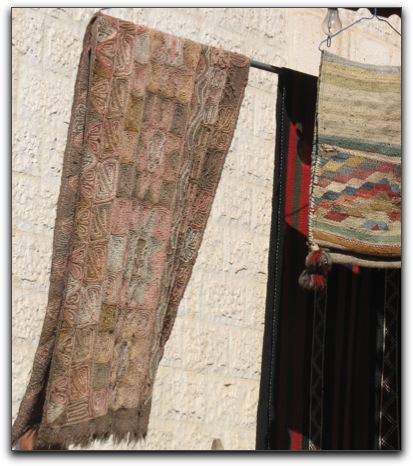
and brass-ware with beautiful Arabic script. Our destination is the St. George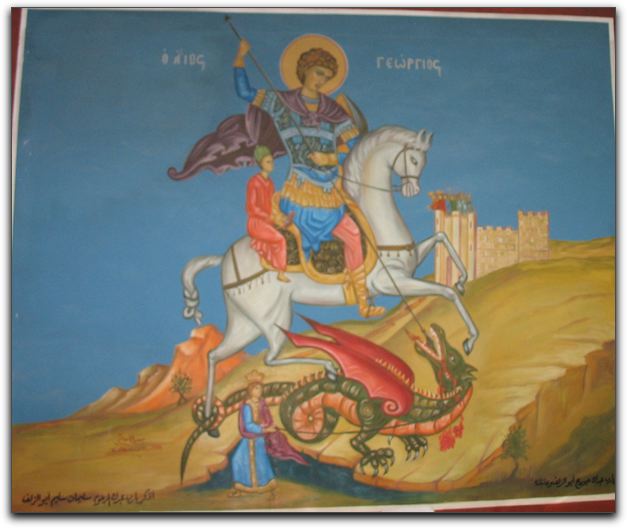
[yes, of dragon-slaying fame] Orthodox Church of Madaba, where the Byzantine floor features the oldest map of the holy land, represented with great accuracy using the Bible as its main resource. [Libbe takes notes while Fadi explains (that’s the north-east corner of Dead Sea at their feet… which gives a sense of the scale of the map that I’ve not gotten from reproductions I (Mark) have seen.)]: 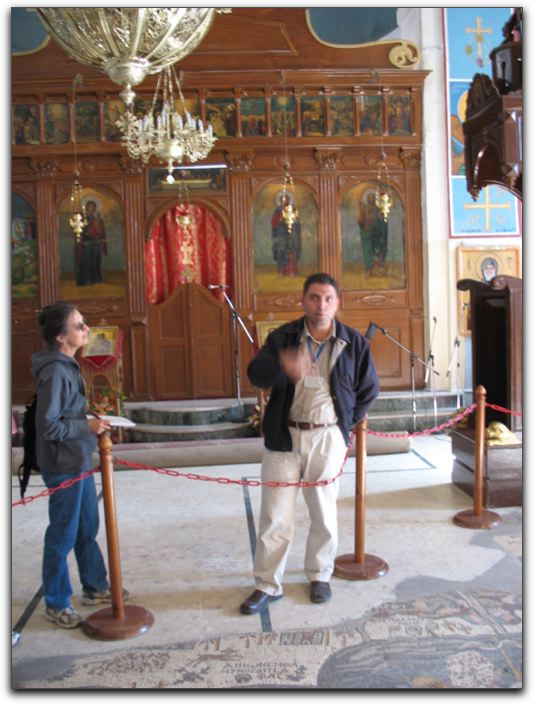
The map originally covered the entire floor of the church, 90 square meters; what remains is about one third, including the city of Jerusalem. The faces in this mosaic and others were destroyed during the iconoclast period, perhaps as a response to growing Islamic ideas. The current Madaba church was built in 1880.
Next, a short drive to Mt. Nebo where we take our final group photo in front of a giant rolling stone that had been part of a gate to close a cave: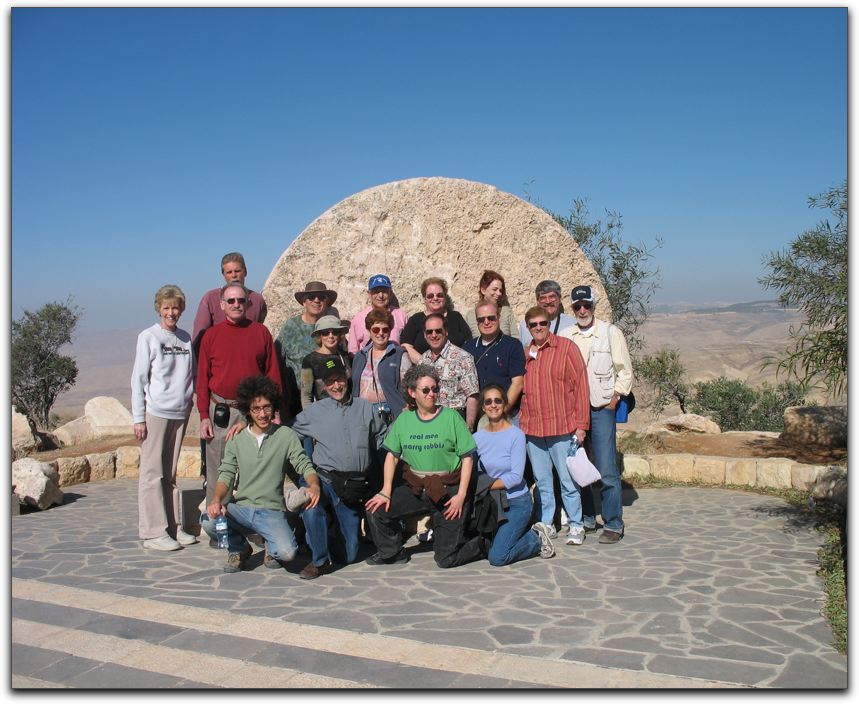
We ‘stand on the rock where Moses stood’ to see the Promised Land.
Ira checks our precise position.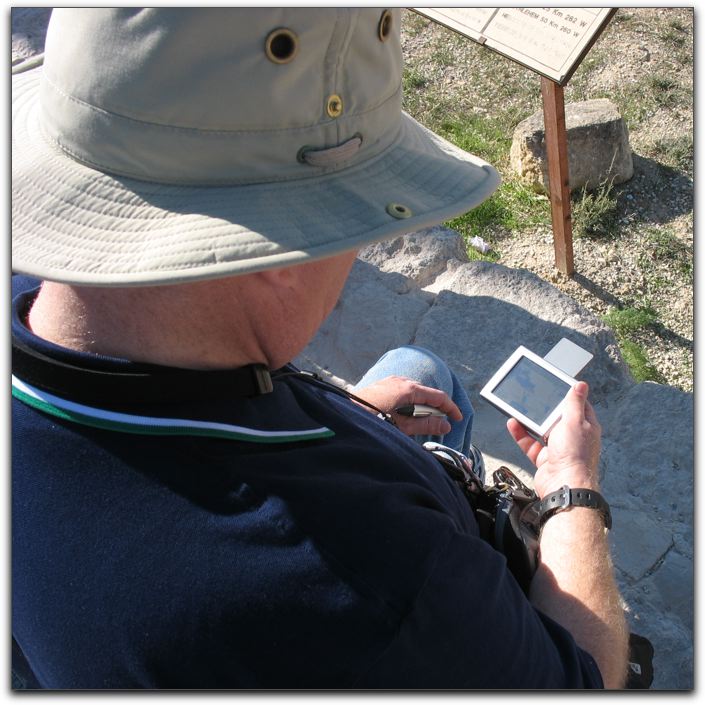
The view is vast [Loren “photoshopped” the picture],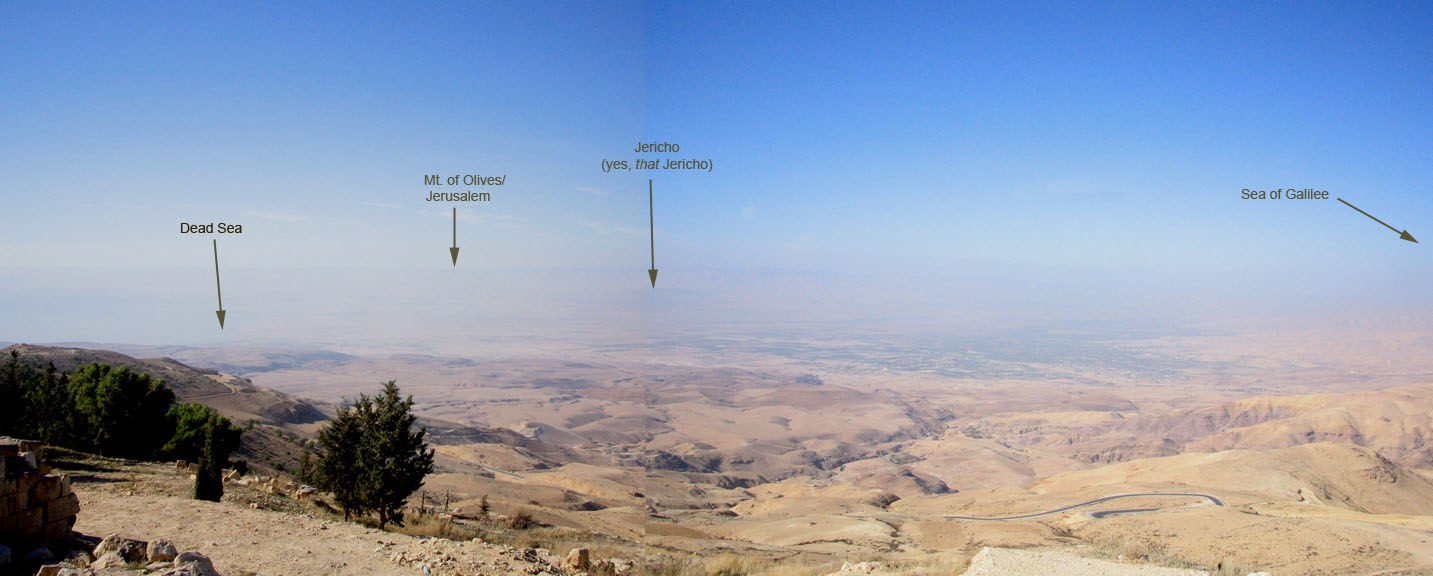
but not quite clear enough to see all the sites indicated on the legend posted.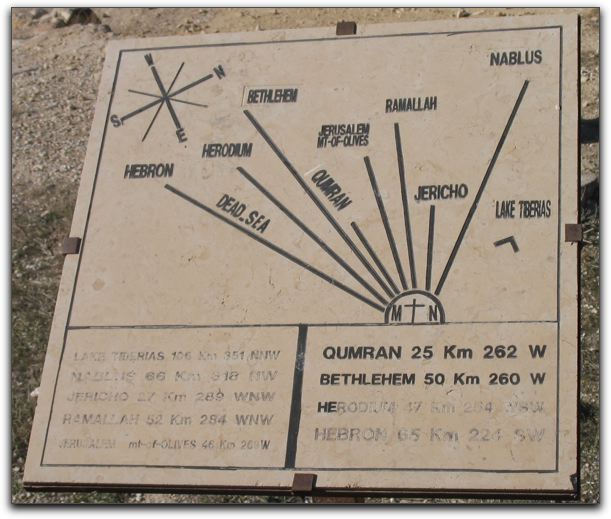
Inside the church here are more beautiful mosaics, 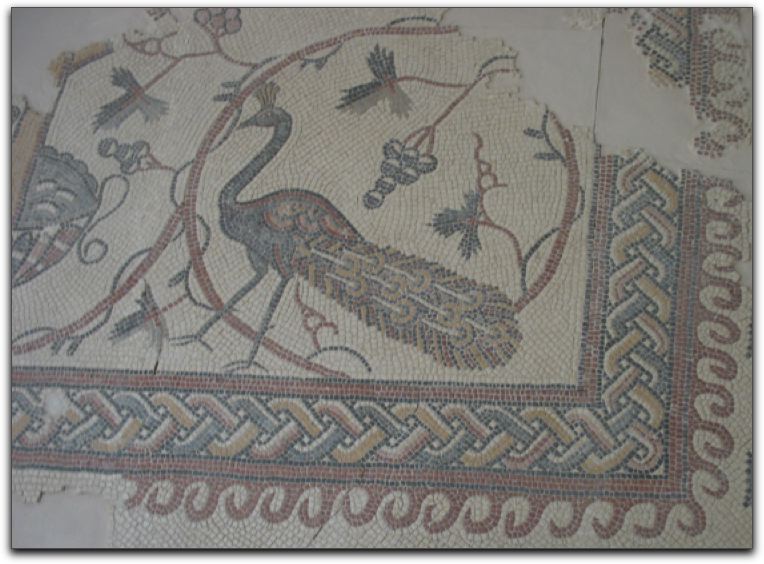
well-preserved because they had been covered by another layer of mosaics during the iconoclast period. One even depicts the Temple in Jerusalem: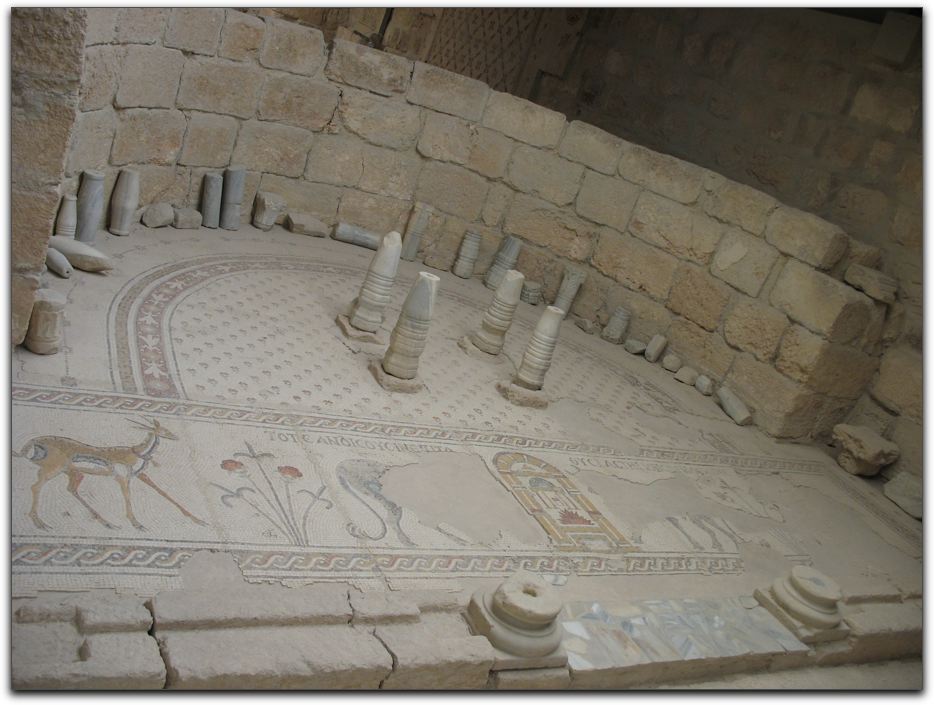
On our way down to the Jordan Valley we pass more Bedouin camps, with sheep, goats, tents, and trucks. Approaching the King Hussein (Allenby) Bridge we encounter several flocks of sheep crossing the road, and again children - this time returning home from school at noon. This is the Jordanian side of the border, where Fadi spends almost an hour dealing with our passports, reporting that the computer is down. We say goodbye to Fadi, and driving us across the bridge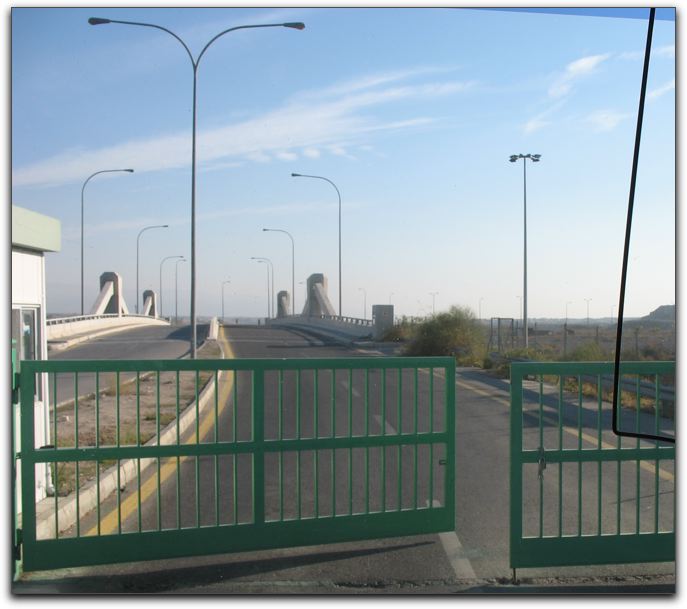
Hassam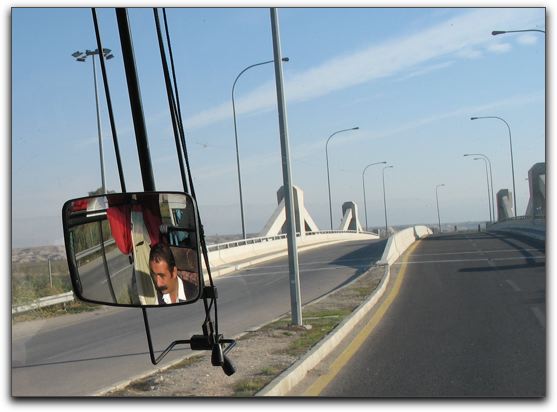
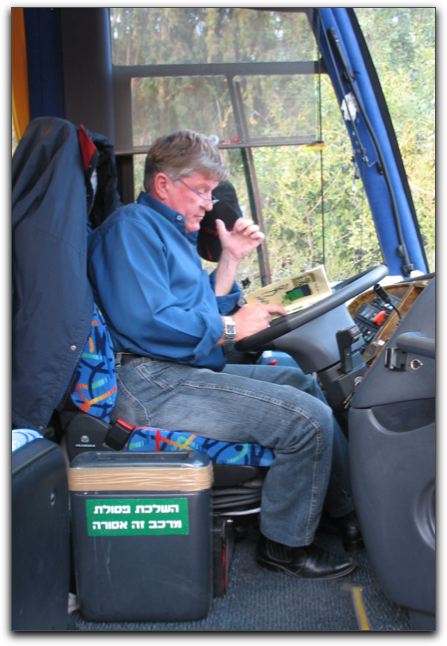 our Israeli bus driver.
our Israeli bus driver.
Our ‘second’ visit to Israel feels a little familiar, like coming home.
Our way up to Jerusalem includes a delay for road construction and then for a convoy of VIP cars which we later learn brought Condoleeza Rice to meet with Prime Minister Olmert.
Ein Kerem, our final destination, is an old Arab village near Jerusalem which in 1948 “became” Jewish. The hillside is covered with houses of various shapes and sizes, with Hadassah Hospital at the top. We walk the village briefly and then head to Walter’s home where Paula greets us with a wonderful spread before our delicious farewell dinner at the Bistro. Our goodbyes are somewhat complicated by the continuing strike and uncertainty about whether and when flights will depart. Even so, warm thanks and goodbyes are shared as each and all go ‘on our way.’ It’s been a wonderful trip!
back || begin again